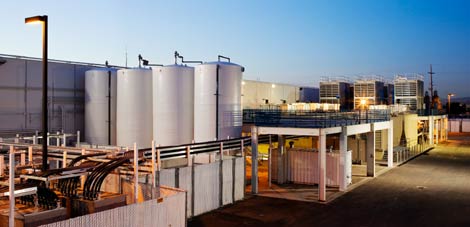
The new Fortune Data Centers facility in San Jose, Calif.
With the enterprise sector thinking green, John Sheputis spends a lot of time talking about the energy efficiency of the new Fortune Data Centers facility in San Jose, Calif. Sheputis, the CEO of Fortune, says the 78,000 square foot facility is on track to earn a Gold LEED (Leadership in Energy and Environmental Design) certification from the U.S. Green Building Council.
The payoff - the green the matters most - is that the Fortune data center has opened its doors with an anchor tenant occupying more than a quarter of its 43,000 square feet of equipment space. Sheputis didn't disclose the tenant's identity, but predicted that it will have company soon.
"There's not a lot of new data center supply coming online" in Silicon Valley, Sheputis said. "There are certainly large tenants in the market."
The energy efficiency piece is critical, Sheputis said, because it has quickly become a key decision point for tenants. "One of the major things I've seen changing in the business is the focus on efficiency," he said. "A year ago, I wouldn't have thought that (energy metrics) would have been this important. It's taken the industry by storm."
In particular, customers are focused on Power Usage Effectiveness, the Green Grid metric that compares a facility’s total power usage to the amount of power used by the IT equipment, revealing how much is lost in distribution and conversion. An average PUE of 2.0 indicates that the IT equipment uses about 50 percent of the power to the building.
PUE of 1.37
In tests using load banks at full capacity, Fortune's San Jose site had a PUE of 1.37. The facility's energy efficiency features include a design that uses a slab floor and drops cool air into the data center from above, taking advantage of the natural tendency for denser cool air to fall while warm air rises. "We had 40,000 square feet of raised floor in the building and we took it out," said Sheputis, who said the raised-floor design wastes the energy required to pump the cold air under the flooring and up into the data center.
Fortune also separated the hot and cold air with vinyl curtains between the top of the racks and the ceiling, preventing warm air from mixing back in with cool air for the servers. The facility employs water-side economization and highly-efficient cooling towers, as well as an advanced building management system to monitor and manage environmental conditions.
Finding Savings in a Retrofit
How did Fortune Data Centers manage to build a new data center in the midst of a credit crisis? Sheputis and his partners secured their funding in late 2007, before the credit crunch took hold. After five months scouting locations, they acquired a former Seagate fabrication facility last year, and spent six months converting it for data center use. The conversion costs were lower than a typical retrofit because the facility had a number of key infrastructure features already in place, including 8 megawatts of power capacity, a 100,000 gallon water storage tank, and a seismic isolation system.
Once Fortune finds additional tenants, it will build the second phase of the San Jose facility and expand the site's power capacity. With additional space, the company says it can utilize more than 10 megawatts of power, which would qualify it for local utility PG&E's transmission rate. that offers a potential competitive advantage, as the transmission rate is cheaper than PG&E's standard industrial rate and also priced lower than Silicon Valley Power, the local utility in nearby Santa Clara.
The San Jose data center is equipped with seven generators providing 14.75 megawatts of backup power. The facility is carrier neutral, with diverse paths and multiple points of network entry. AboveNet, Level3, and AT&T are on-site.



